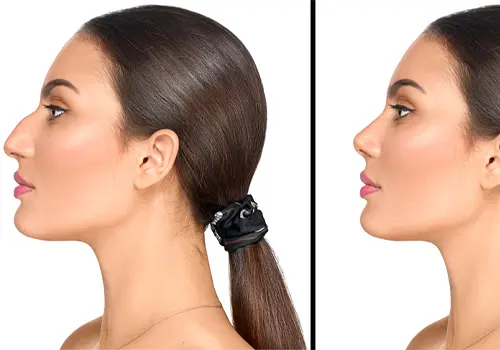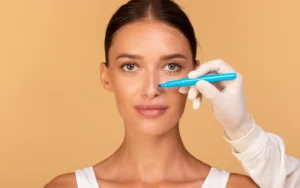Introduction
In addition to the expenditure of time, and money, and the physical strain associated with surgery, the act of undergoing surgery also introduces stress and mental anxieties for people. Rhinoplasty, commonly known as a “nose job,” exemplifies a surgical procedure. Typically, patients expect the final results of rhinoplasty to align with their pre-surgery consulting and envisioning with the plastic surgeon. However, for various reasons, this expectation may not always be feasible. This is where “Dr.Maadico” comes to your aid, in Iran. In this article, we will explore Revision Rhinoplasty together.
What is Revision Rhinoplasty Surgery?
Revision Rhinoplasty is performed when adjustments are needed after the primary rhinoplasty procedure. Secondary rhinoplasty is more intricate than primary rhinoplasty. The reasons for this complexity can vary, whether the initial nose surgery was for cosmetic purposes, to address functional issues, or due to potential nose damage. Several factors contribute to the intricacy of nose revision surgery. For example, the surgical techniques employed during the primary rhinoplasty, insufficient corrections made during the initial procedure, or the results attained from the primary rhinoplasty.
For example, In some instances, the surgeon may have removed more cartilage and bone tissue from the nose than necessary during the primary surgery. In some cases, the skin surrounding the nose can become wrinkled, which, if the nose has a weak structure, can lead to discomfort for the patient.
For example, Over-reduction of the nasal tip can give it a pinched appearance or excessive removal of the nose bridge can lead to a “Ski Slope Nose,” sometimes referred to as the “Miss Piggy” nose. These issues can also cause respiratory problems in patients. Hence, selecting a skilled plastic surgeon is a crucial step in your nose surgery journey. This is where “Dr. Maadico” can provide invaluable guidance for your cosmetic surgery needs.
What is the Revision Rhinoplasty Procedure?
In secondary Rhinoplasty surgery, the plastic surgeon performs adjustments based on the results of the primary nose job done for you. Depending on her observations of the condition of the patient’s nose after primary rhinoplasty, he/she uses an open method (making an incision across the columella) or a closed method (making an incision inside the nose) for the patient’s surgery. These results may include the presence of scar tissue around the nose, deformities in the nose’s appearance, or functional and structural issues. The plastic surgeon may utilize cartilage tissue grafts from the patient’s ears or ribs to correct these deformities. In certain cases, the surgeon may use implants for corrective nose surgery.

Recommended time frame considering revision rhinoplasty
Since it takes about a year to see the final results of the primary nose surgery, it is advisable to wait at least six to nine months after the initial procedure before undergoing Secondary rhinoplasty. This allows for the resolution of any residual swelling, and the nose will have reached its final form.
Revision Rhinoplasty surgery facts
| 2-3 hours depending on the complexity | Duration |
| General | Anesthesia |
| 10-14 days | Rest Time |
Recovery after Revision Rhinoplasty
Recovery after corrective nose surgery generally parallels that of primary rhinoplasty and includes the following:
- Avoid any trauma to the nose for the first few weeks (as your surgery is a secondary procedure, this precaution is crucial).
- In cases where the patient’s cartilaginous tissue is used for nose revision surgery, there is a secondary recovery aspect.
- Please avoid participating in vigorous physical activities or lifting heavy objects for a minimum of one month after the surgery
- If you wear glasses, it’s advisable to minimize the pressure on your nose for seven weeks.
Who Is an Ideal Candidate for Revision Rhinoplasty?
Revision Rhinoplasty is typically recommended for the following scenarios:
- When excessive cartilage and bone were removed during the primary nose surgery.
- When the primary nose surgery results in breathing difficulties.
- When the primary nose surgery causes nasal deviation.
- When there’s a need to create facial symmetry due to overcorrection or incorrect adjustment of the nose, which affects its size, shape, or projection, disturbing the facial balance.
- To address scars left from the primary rhinoplasty.
- In cases where implant displacement or tissue damage occurs following the primary rhinoplasty.
To be considered a suitable candidate for Revision rhinoplasty, patients should meet the following criteria:
- General good health.
- Non-smoking status.
- Realistic expectations regarding the outcome of Secondary rhinoplasty.

Male Revision rhinoplasty VS women, what is the difference?
As discussed in the context of rhinoplasty, the rhinoplasty process for both men and women is generally similar. Depending on the surgeon’s preference, they may choose to perform either open rhinoplasty or closed rhinoplasty on patients of both sexes. In terms of nose deviation correction surgery or septoplasty, there are some distinctions between men and women :
- Men have a higher likelihood of experiencing accidents that impact their facial appearance, including injuries from various occupational or sports-related incidents. Consequently, the need for corrective nose surgery is more common among men than women.
- Notably, men typically possess longer nasal bridges and thicker nasal skin compared to women. Consequently, in revision, rhinoplasty for men may require more grafts to achieve the desired results. It’s because a greater amount of cartilage is required to reinforce the nasal bridge in male patients. Additionally, the recovery period following the surgery may vary between male and female patients
What Are the Risks of Revision Rhinoplasty?
General risks associated with any surgical procedure include issues such as excessive bleeding and adverse reactions to anesthesia. Specific risks related to the condition of the nose following the primary surgery may include nasal septum perforation and changes in skin color, as well as breathing problems.
Combining Revision Rhinoplasty with Other Cosmetic Procedures
In certain cases, a plastic surgeon may recommend additional cosmetic surgeries, such as an eyebrow lift, facelift, eyelid surgery, or chin augmentation, to harmonize facial features. It’s important to note that opting for multiple procedures can extend the recovery period.
Is Non-Surgical Revision Rhinoplasty Possible?
Thanks to cosmetic fillers, it has become possible to change the nose’s appearance without nose surgery. Patients can achieve the desired changes to their noses without undergoing surgery.
Cosmetic fillers can be used to address aesthetic flaws in both primary and secondary Rhinoplasty. This approach is known as “liquid rhinoplasty” and can be employed to correct issues like a drooping tip, excessive nasal slope, or minor nasal deviation. Liquid rhinoplasty is a minimally invasive procedure where fillers are used to reshape and enhance the appearance of the nose. It is sometimes referred to as the “15-minute nose surgery.”
Depending on the patient’s needs and the surgeon’s recommendations, this method can be suitable. For instance, consider a patient who requires corrective nose surgery but is constrained by factors like employment commitments and the requisite recovery period for a secondary rhinoplasty.
In such cases, there may be a need to utilize cosmetic fillers to achieve the desired changes in the nose’s appearance until the cosmetic surgeon proceeds with the aesthetic nose surgery or nose operation. However, it’s essential to remember that the cosmetic fillers used in this procedure are temporary or semi-permanent and require periodic maintenance for longer-lasting results.
One example of fillers that are used in this method is Restylane, an FDA-approved hyaluronic acid filler with a shelf life of 9-12 months. It should be administered by a qualified plastic surgeon.

Typically, fillers are employed to address the following issues in the nose:
- Creating symmetry on both sides of the nose and balancing its appearance.
- Improving minor nasal irregularities and achieving a smoother nasal contour.
- Enhancing the nasal tip by increasing volume to provide a longer and more prominent appearance.
The recovery period for liquid rhinoplasty
In general, the use of injectable fillers can lead to bruising and temporary swelling for the patient. Most of these side effects typically subside within two weeks. However, it’s essential to be mindful of certain precautions during the initial 48 hours post-injection, including the following:
- Avoid wearing glasses for the first 36 hours after the injection.
- Refrain from applying pressure to the nose during the initial 36 hours post-injection.
- Avoid engaging in strenuous physical activities within the first 48 hours after the injection.
- Patients should not sleep on their side or stomach for several days following the injection.
- It’s advisable for patients to sleep on their back for a few days after the injection, ideally with their head slightly elevated.
If you’re ready for a change, request a free consultation.
FAQs
- Is There an Age Limit for Rhinoplasty?
Generally, candidates must be at least 16 years old to undergo rhinoplasty, whether it’s for primary or secondary purposes.
- What Does the Consultation Before Revision Rhinoplasty Surgery Include?
Just as with your primary nose job, the plastic surgeon will assess the structure of your nose and review your medical history as part of the standard procedure.
During this process, you’ll be informed about various aspects of corrective nose surgery, such as surgical techniques, anesthesia, recovery, potential risks, and more. Your surgical goals will be discussed, and a digital imaging of your nose may be performed.
- What Are the Risks of Revision Rhinoplasty?
Generally, rhinoplasty is a complex surgical procedure and is associated with inherent risks. Selecting the right surgeon for your secondary nose surgery is the crucial first step in minimizing these risks. Potential complications include bleeding, adverse reactions to medication, nasal obstruction, the development of additional scar tissue, the possibility of infection, and temporary loss of the sense of smell.
- How Long Does Revision Rhinoplasty Take?
The duration of the surgery depends on the patient’s circumstances, which can affect the length of the procedure required to achieve the desired results.

- Why Is Iran Considered a Suitable Destination for Corrective Nose Surgery?
The choice of a destination for cosmetic surgery is a personal decision. Today, Iran is recognized as one of the world’s most renowned centers for rhinoplasty. The country is home to highly skilled and renowned plastic surgeons who have extensive experience in performing both primary and secondary rhinoplasty procedures.
Furthermore, when compared to Western countries, Iran offers more cost-effective medical and beauty services. This affordability has contributed to its status as a popular destination for medical tourism.
- Is it safe to undergo cosmetic filler treatments while pregnant or breastfeeding?
Typically, a plastic surgeon needs a comprehensive understanding of the patient’s medical history, primarily to identify potential allergic reactions to the medicinal or cosmetic products they might use. Dermal fillers should not be administered to individuals who are pregnant or breastfeeding.
Additionally, it is not advisable for those with immune deficiencies or autoimmune diseases. In general, dermal fillers have the potential to provoke skin irritation in users.


